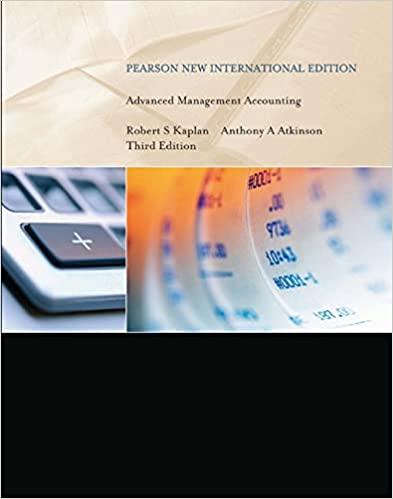Question
Which of the following refers to standards that allow for no machine breakdowns or other work interruptions and that require peak efficiency at all times?
- Which of the following refers to standards that allow for no machine breakdowns or other work interruptions and that require peak efficiency at all times?
A) Normal standards. B) Practical standards. C) Ideal standards. D) Budgeted standards.
- To measure controllable production inefficiencies, which of the following is the best basis for a company to use in establishing the standard hours allowed for the output of one unit of product?
- Average historical performance for the last several years.
- Engineering estimates based on ideal performance.
- Engineering estimates based on attainable performance.
- The hours per unit that would be required for the present workforce to satisfy expected demand over the long run.
13. Which of the following statements concerning practical standards is NOT correct? A) Practical standards can be used for product costing and cash budgeting.
- Practical standards can be attained by the average worker.
- When practical standards are used, there is no reason to adjust standards if an old machine is replaced by a newer, faster machine.
- Under practical standards, large variances are less likely than under ideal standards.
14. If a company follows a practice of isolating variances at the earliest point in time, what would be the appropriate time to isolate and recognize a direct material price variance?
- When material is issued. C) When material is used in production.
- When material is purchased. D) When production is completed.
15. What does an unfavourable labour efficiency variance indicate? A) The actual labour rate was higher than the standard labour rate.
- The labour rate variance must also be unfavourable.
- Actual labour hours worked exceeded standard labour hours for the production level achieved.
- Overtime labour was used during the period.
16. What does a favourable labour rate variance indicate?
A) Actual hours exceed standard hours. C) The actual rate exceeds the standard rate. B) Standard hours exceed actual hours. D) The standard rate exceeds the actual rate.
17. The cash budget must be prepared before you can complete which of the following?
- Production budget. C) Raw materials purchases budget.
- Budgeted balance sheet. D) Schedule of cash disbursements.
18. Which of the following is not a benefit of budgeting? A) It uncovers potential bottlenecks before they occur.
- It coordinates the activities of the entire organization by integrating the plans and objectives of the various parts.
- It ensures that accounting records comply with generally accepted accounting principles.
- It provides benchmarks for evaluating subsequent performance.
19. Which of the following best describes the direct materials purchase budget? A) It is the beginning point in the budget process.
- It must provide for the desired ending inventory as well as for production.
- It is accompanied by a schedule of cash collections.
- It is completed after the cash budget.
20. The master budget process usually begins with which of the following?
A) Production budget. B) Operating budget. C) Sales budget. D) Cash budget.
Step by Step Solution
There are 3 Steps involved in it
Step: 1

Get Instant Access to Expert-Tailored Solutions
See step-by-step solutions with expert insights and AI powered tools for academic success
Step: 2

Step: 3

Ace Your Homework with AI
Get the answers you need in no time with our AI-driven, step-by-step assistance
Get Started


